Analysis of Tesco's Accounting Scandals and Performance Impact
VerifiedAdded on 2020/05/08
|24
|5762
|40
Report
AI Summary
This report delves into the accounting scandal that engulfed Tesco, a major UK supermarket chain, focusing on the misstatement of profits and its wide-ranging consequences. It explores the factors that led to the fraud, including gaps in internal controls, auditing failures, and employee incentives, while also examining the concealment of the fraud for an extended period. The report analyzes the impact of the scandal on Tesco's financial performance, stakeholders, and overall organizational health. It further investigates the application of the fraud triangle model to understand the motivations behind the fraudulent activities. The report concludes with recommendations for future prevention, emphasizing sound accounting practices, robust internal controls, effective employee incentive policies, and enterprise risk assessment strategies to mitigate the risk of similar scandals. Data from various sources, including news articles, websites, and annual reports, were used to support the findings and analysis.
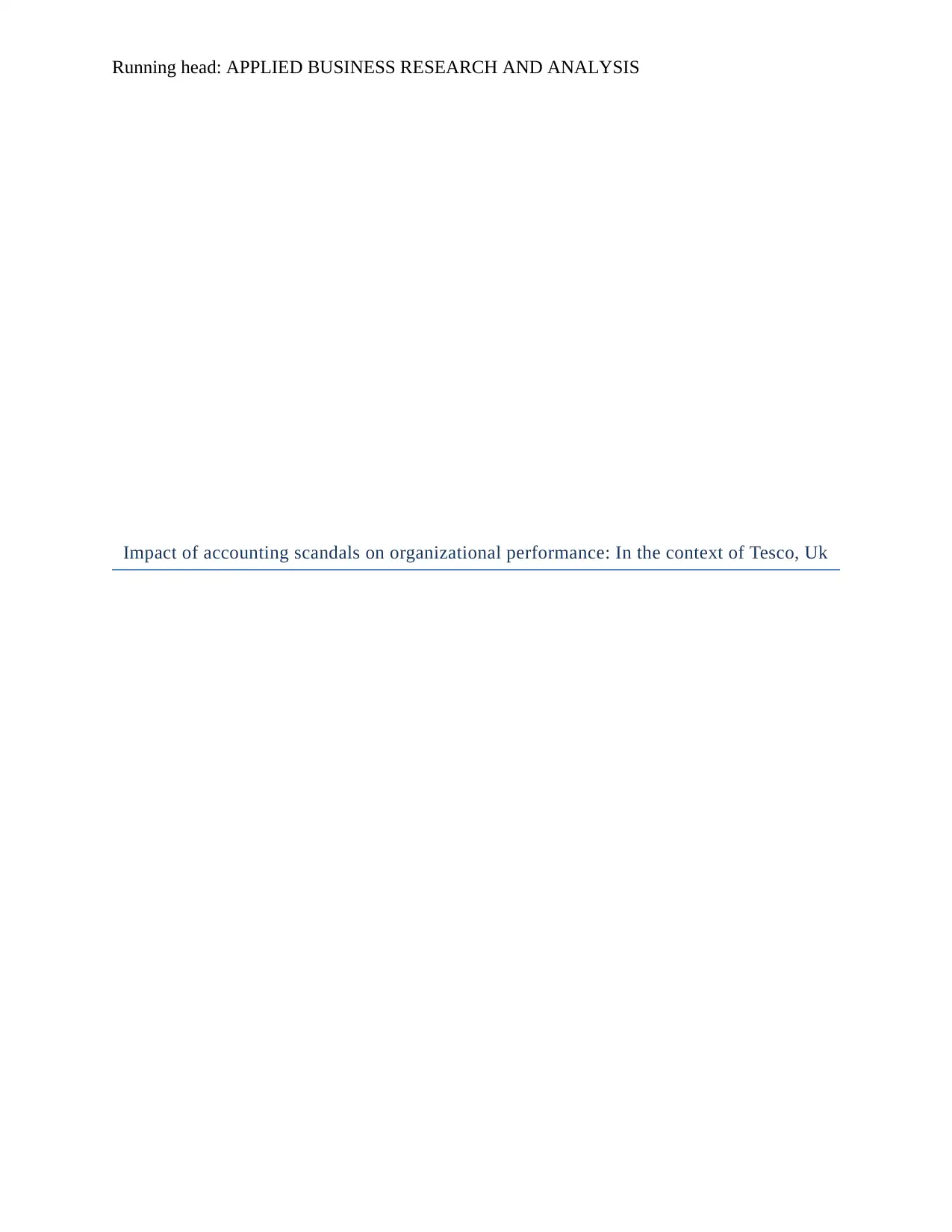
Running head: APPLIED BUSINESS RESEARCH AND ANALYSIS
Impact of accounting scandals on organizational performance: In the context of Tesco, Uk
Impact of accounting scandals on organizational performance: In the context of Tesco, Uk
Paraphrase This Document
Need a fresh take? Get an instant paraphrase of this document with our AI Paraphraser
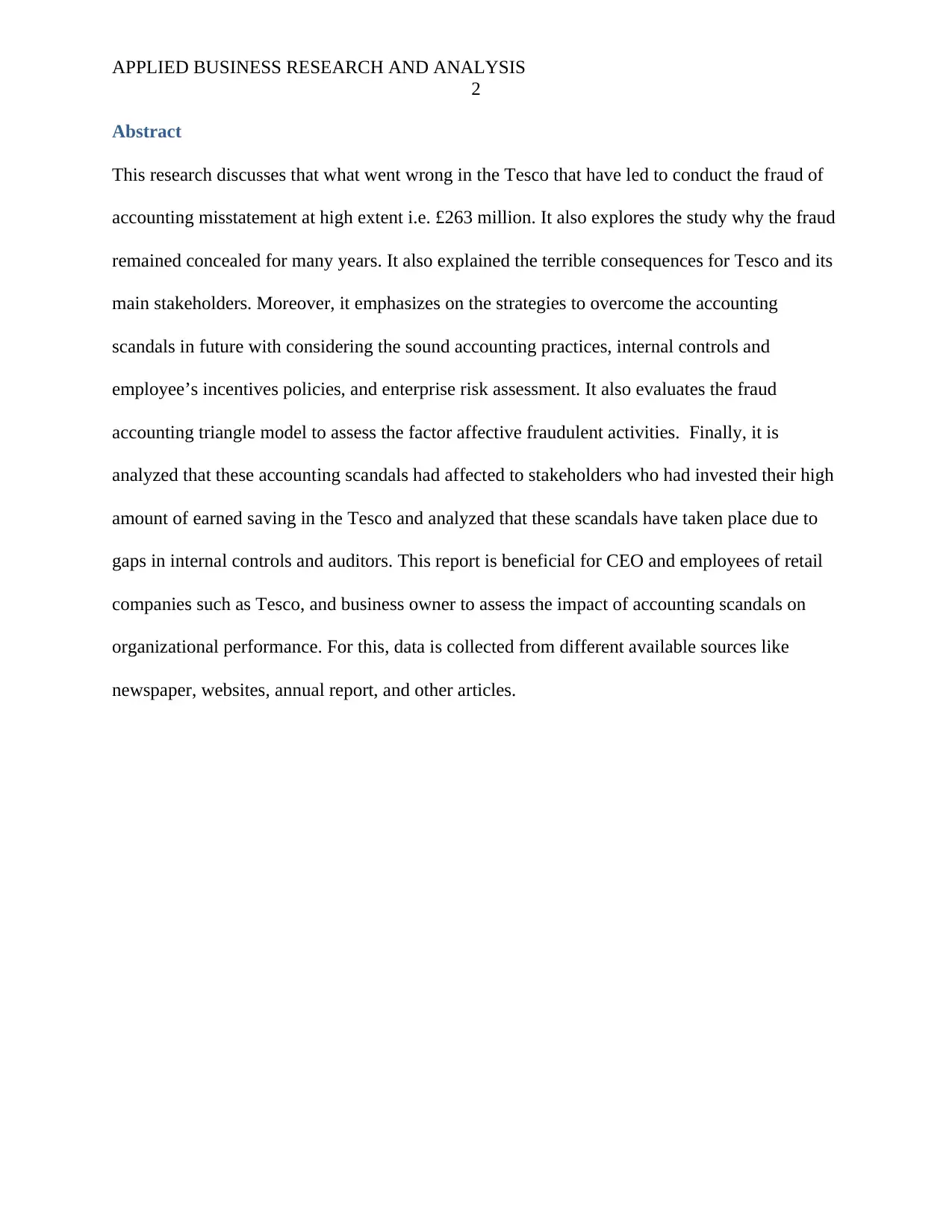
APPLIED BUSINESS RESEARCH AND ANALYSIS
2
Abstract
This research discusses that what went wrong in the Tesco that have led to conduct the fraud of
accounting misstatement at high extent i.e. £263 million. It also explores the study why the fraud
remained concealed for many years. It also explained the terrible consequences for Tesco and its
main stakeholders. Moreover, it emphasizes on the strategies to overcome the accounting
scandals in future with considering the sound accounting practices, internal controls and
employee’s incentives policies, and enterprise risk assessment. It also evaluates the fraud
accounting triangle model to assess the factor affective fraudulent activities. Finally, it is
analyzed that these accounting scandals had affected to stakeholders who had invested their high
amount of earned saving in the Tesco and analyzed that these scandals have taken place due to
gaps in internal controls and auditors. This report is beneficial for CEO and employees of retail
companies such as Tesco, and business owner to assess the impact of accounting scandals on
organizational performance. For this, data is collected from different available sources like
newspaper, websites, annual report, and other articles.
2
Abstract
This research discusses that what went wrong in the Tesco that have led to conduct the fraud of
accounting misstatement at high extent i.e. £263 million. It also explores the study why the fraud
remained concealed for many years. It also explained the terrible consequences for Tesco and its
main stakeholders. Moreover, it emphasizes on the strategies to overcome the accounting
scandals in future with considering the sound accounting practices, internal controls and
employee’s incentives policies, and enterprise risk assessment. It also evaluates the fraud
accounting triangle model to assess the factor affective fraudulent activities. Finally, it is
analyzed that these accounting scandals had affected to stakeholders who had invested their high
amount of earned saving in the Tesco and analyzed that these scandals have taken place due to
gaps in internal controls and auditors. This report is beneficial for CEO and employees of retail
companies such as Tesco, and business owner to assess the impact of accounting scandals on
organizational performance. For this, data is collected from different available sources like
newspaper, websites, annual report, and other articles.
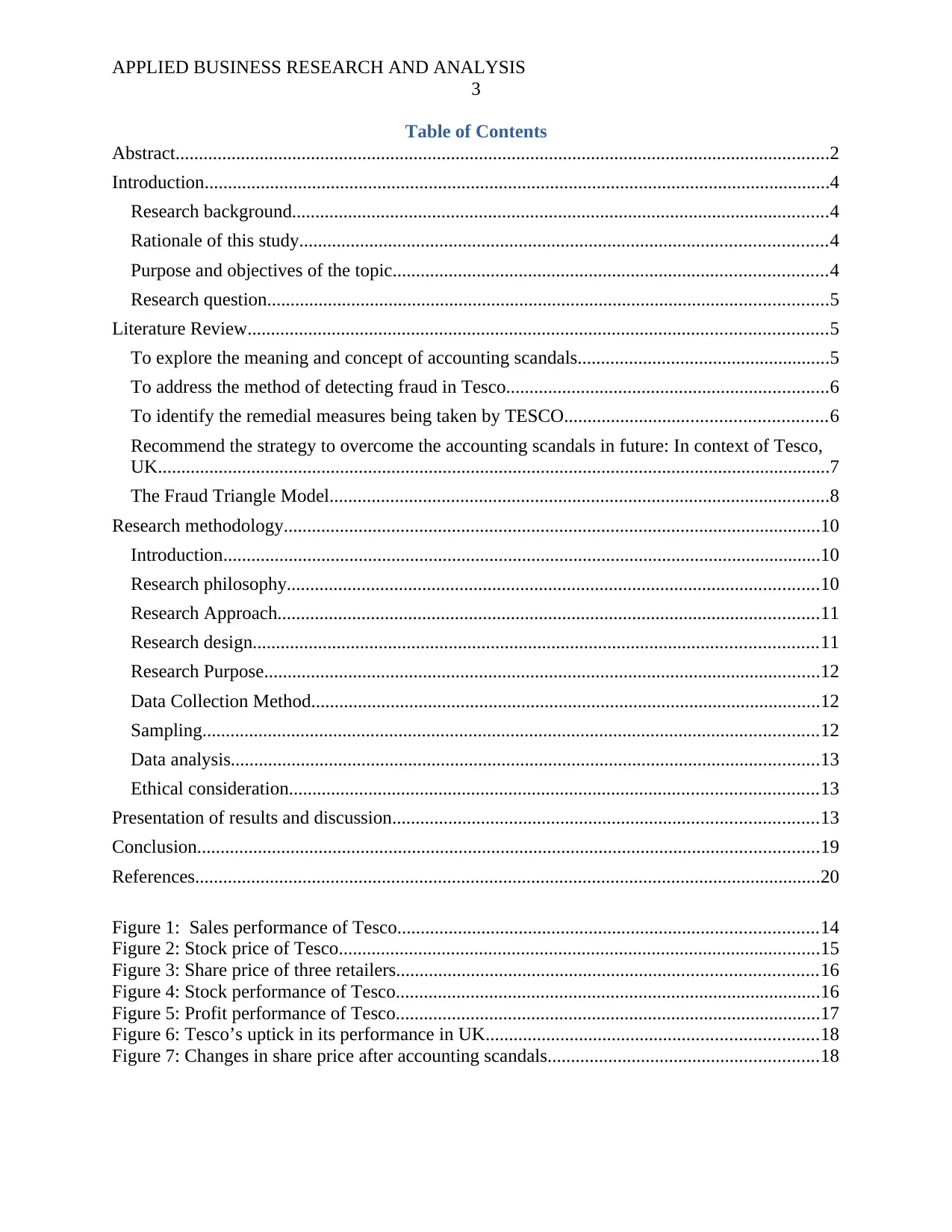
APPLIED BUSINESS RESEARCH AND ANALYSIS
3
Table of Contents
Abstract............................................................................................................................................2
Introduction......................................................................................................................................4
Research background...................................................................................................................4
Rationale of this study.................................................................................................................4
Purpose and objectives of the topic.............................................................................................4
Research question........................................................................................................................5
Literature Review............................................................................................................................5
To explore the meaning and concept of accounting scandals......................................................5
To address the method of detecting fraud in Tesco.....................................................................6
To identify the remedial measures being taken by TESCO........................................................6
Recommend the strategy to overcome the accounting scandals in future: In context of Tesco,
UK................................................................................................................................................7
The Fraud Triangle Model...........................................................................................................8
Research methodology...................................................................................................................10
Introduction................................................................................................................................10
Research philosophy..................................................................................................................10
Research Approach....................................................................................................................11
Research design.........................................................................................................................11
Research Purpose.......................................................................................................................12
Data Collection Method.............................................................................................................12
Sampling....................................................................................................................................12
Data analysis..............................................................................................................................13
Ethical consideration.................................................................................................................13
Presentation of results and discussion...........................................................................................13
Conclusion.....................................................................................................................................19
References......................................................................................................................................20
Figure 1: Sales performance of Tesco..........................................................................................14
Figure 2: Stock price of Tesco.......................................................................................................15
Figure 3: Share price of three retailers..........................................................................................16
Figure 4: Stock performance of Tesco...........................................................................................16
Figure 5: Profit performance of Tesco...........................................................................................17
Figure 6: Tesco’s uptick in its performance in UK.......................................................................18
Figure 7: Changes in share price after accounting scandals..........................................................18
3
Table of Contents
Abstract............................................................................................................................................2
Introduction......................................................................................................................................4
Research background...................................................................................................................4
Rationale of this study.................................................................................................................4
Purpose and objectives of the topic.............................................................................................4
Research question........................................................................................................................5
Literature Review............................................................................................................................5
To explore the meaning and concept of accounting scandals......................................................5
To address the method of detecting fraud in Tesco.....................................................................6
To identify the remedial measures being taken by TESCO........................................................6
Recommend the strategy to overcome the accounting scandals in future: In context of Tesco,
UK................................................................................................................................................7
The Fraud Triangle Model...........................................................................................................8
Research methodology...................................................................................................................10
Introduction................................................................................................................................10
Research philosophy..................................................................................................................10
Research Approach....................................................................................................................11
Research design.........................................................................................................................11
Research Purpose.......................................................................................................................12
Data Collection Method.............................................................................................................12
Sampling....................................................................................................................................12
Data analysis..............................................................................................................................13
Ethical consideration.................................................................................................................13
Presentation of results and discussion...........................................................................................13
Conclusion.....................................................................................................................................19
References......................................................................................................................................20
Figure 1: Sales performance of Tesco..........................................................................................14
Figure 2: Stock price of Tesco.......................................................................................................15
Figure 3: Share price of three retailers..........................................................................................16
Figure 4: Stock performance of Tesco...........................................................................................16
Figure 5: Profit performance of Tesco...........................................................................................17
Figure 6: Tesco’s uptick in its performance in UK.......................................................................18
Figure 7: Changes in share price after accounting scandals..........................................................18
⊘ This is a preview!⊘
Do you want full access?
Subscribe today to unlock all pages.

Trusted by 1+ million students worldwide
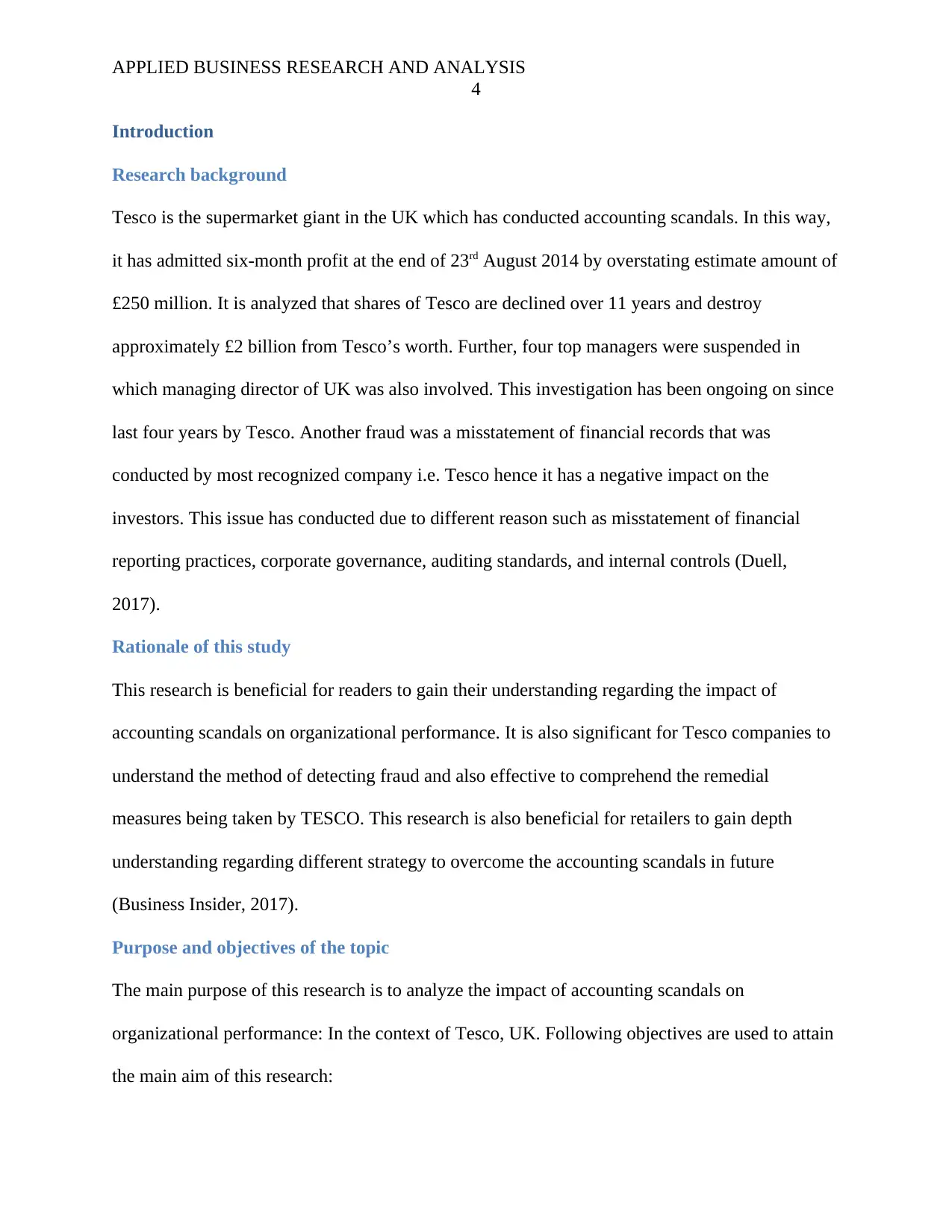
APPLIED BUSINESS RESEARCH AND ANALYSIS
4
Introduction
Research background
Tesco is the supermarket giant in the UK which has conducted accounting scandals. In this way,
it has admitted six-month profit at the end of 23rd August 2014 by overstating estimate amount of
£250 million. It is analyzed that shares of Tesco are declined over 11 years and destroy
approximately £2 billion from Tesco’s worth. Further, four top managers were suspended in
which managing director of UK was also involved. This investigation has been ongoing on since
last four years by Tesco. Another fraud was a misstatement of financial records that was
conducted by most recognized company i.e. Tesco hence it has a negative impact on the
investors. This issue has conducted due to different reason such as misstatement of financial
reporting practices, corporate governance, auditing standards, and internal controls (Duell,
2017).
Rationale of this study
This research is beneficial for readers to gain their understanding regarding the impact of
accounting scandals on organizational performance. It is also significant for Tesco companies to
understand the method of detecting fraud and also effective to comprehend the remedial
measures being taken by TESCO. This research is also beneficial for retailers to gain depth
understanding regarding different strategy to overcome the accounting scandals in future
(Business Insider, 2017).
Purpose and objectives of the topic
The main purpose of this research is to analyze the impact of accounting scandals on
organizational performance: In the context of Tesco, UK. Following objectives are used to attain
the main aim of this research:
4
Introduction
Research background
Tesco is the supermarket giant in the UK which has conducted accounting scandals. In this way,
it has admitted six-month profit at the end of 23rd August 2014 by overstating estimate amount of
£250 million. It is analyzed that shares of Tesco are declined over 11 years and destroy
approximately £2 billion from Tesco’s worth. Further, four top managers were suspended in
which managing director of UK was also involved. This investigation has been ongoing on since
last four years by Tesco. Another fraud was a misstatement of financial records that was
conducted by most recognized company i.e. Tesco hence it has a negative impact on the
investors. This issue has conducted due to different reason such as misstatement of financial
reporting practices, corporate governance, auditing standards, and internal controls (Duell,
2017).
Rationale of this study
This research is beneficial for readers to gain their understanding regarding the impact of
accounting scandals on organizational performance. It is also significant for Tesco companies to
understand the method of detecting fraud and also effective to comprehend the remedial
measures being taken by TESCO. This research is also beneficial for retailers to gain depth
understanding regarding different strategy to overcome the accounting scandals in future
(Business Insider, 2017).
Purpose and objectives of the topic
The main purpose of this research is to analyze the impact of accounting scandals on
organizational performance: In the context of Tesco, UK. Following objectives are used to attain
the main aim of this research:
Paraphrase This Document
Need a fresh take? Get an instant paraphrase of this document with our AI Paraphraser
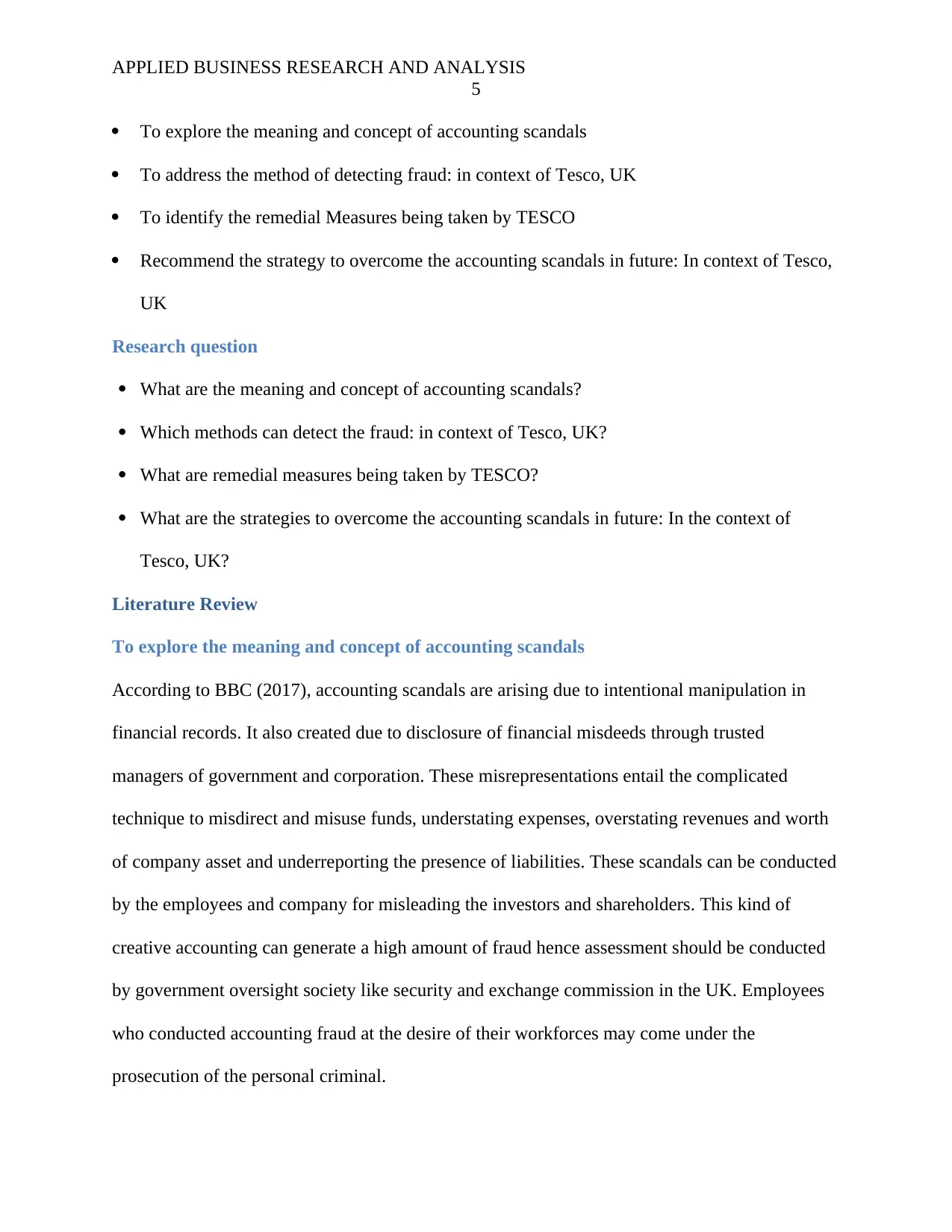
APPLIED BUSINESS RESEARCH AND ANALYSIS
5
To explore the meaning and concept of accounting scandals
To address the method of detecting fraud: in context of Tesco, UK
To identify the remedial Measures being taken by TESCO
Recommend the strategy to overcome the accounting scandals in future: In context of Tesco,
UK
Research question
What are the meaning and concept of accounting scandals?
Which methods can detect the fraud: in context of Tesco, UK?
What are remedial measures being taken by TESCO?
What are the strategies to overcome the accounting scandals in future: In the context of
Tesco, UK?
Literature Review
To explore the meaning and concept of accounting scandals
According to BBC (2017), accounting scandals are arising due to intentional manipulation in
financial records. It also created due to disclosure of financial misdeeds through trusted
managers of government and corporation. These misrepresentations entail the complicated
technique to misdirect and misuse funds, understating expenses, overstating revenues and worth
of company asset and underreporting the presence of liabilities. These scandals can be conducted
by the employees and company for misleading the investors and shareholders. This kind of
creative accounting can generate a high amount of fraud hence assessment should be conducted
by government oversight society like security and exchange commission in the UK. Employees
who conducted accounting fraud at the desire of their workforces may come under the
prosecution of the personal criminal.
5
To explore the meaning and concept of accounting scandals
To address the method of detecting fraud: in context of Tesco, UK
To identify the remedial Measures being taken by TESCO
Recommend the strategy to overcome the accounting scandals in future: In context of Tesco,
UK
Research question
What are the meaning and concept of accounting scandals?
Which methods can detect the fraud: in context of Tesco, UK?
What are remedial measures being taken by TESCO?
What are the strategies to overcome the accounting scandals in future: In the context of
Tesco, UK?
Literature Review
To explore the meaning and concept of accounting scandals
According to BBC (2017), accounting scandals are arising due to intentional manipulation in
financial records. It also created due to disclosure of financial misdeeds through trusted
managers of government and corporation. These misrepresentations entail the complicated
technique to misdirect and misuse funds, understating expenses, overstating revenues and worth
of company asset and underreporting the presence of liabilities. These scandals can be conducted
by the employees and company for misleading the investors and shareholders. This kind of
creative accounting can generate a high amount of fraud hence assessment should be conducted
by government oversight society like security and exchange commission in the UK. Employees
who conducted accounting fraud at the desire of their workforces may come under the
prosecution of the personal criminal.

APPLIED BUSINESS RESEARCH AND ANALYSIS
6
To address the method of detecting fraud in Tesco
In opposed to this, Hope (2016) stated that a whistle-blower through the legal department is
detected by new CEO, Dave Lewis. In such case, the company has estimated its first-half profit
and announced on August 29. It has also overstated by £246 million. The whistleblower was a
member of the finance department. It is concerned that his department was not getting the full
credential associated with commercial revenue. The chairman and CEO have appointed by a
general counsel of Tesco on the situation. It is analyzed that Tesco had announced the
overstatement of revenues on September 22, 2014. According to the audited financial statement
of Tesco for the year of 2014-15, the sum of overstatement regarding profit before tax for the
year 2015 was £53 million and total overstatement of the previous years was £155 million.
To identify the remedial measures being taken by TESCO
Independent (2017) opined that major structural transformations have been started in Tesco.
These are new management team, an overhaul of management structure, moving out from non-
core business, reduction in capital spending, a new code of business conduct, and higher
emphasize on cost price as compared to commercial income. In this way, corporate training
initiative plan can help employees to conduct ethics and compliance at the workplace. Further,
commercial liaison with the suppliers and incentive framework is reset by a commercial team of
Tesco. Along with this, audited financial statement of Tesco for the year 2014-15 is enhanced
and more visible disclosure of its bookkeeping of viable revenue. The company is also focused
on adequate accounting of commercial revenues.
In support to this, The Guardian (2017) stated that external audit of Tesco has been passed to
tender after 32 years along with PwC has equally agreed that they will not engage in the tender.
Tesco also announces new auditors such as Deloitte to make proper auditing. Tesco is also
6
To address the method of detecting fraud in Tesco
In opposed to this, Hope (2016) stated that a whistle-blower through the legal department is
detected by new CEO, Dave Lewis. In such case, the company has estimated its first-half profit
and announced on August 29. It has also overstated by £246 million. The whistleblower was a
member of the finance department. It is concerned that his department was not getting the full
credential associated with commercial revenue. The chairman and CEO have appointed by a
general counsel of Tesco on the situation. It is analyzed that Tesco had announced the
overstatement of revenues on September 22, 2014. According to the audited financial statement
of Tesco for the year of 2014-15, the sum of overstatement regarding profit before tax for the
year 2015 was £53 million and total overstatement of the previous years was £155 million.
To identify the remedial measures being taken by TESCO
Independent (2017) opined that major structural transformations have been started in Tesco.
These are new management team, an overhaul of management structure, moving out from non-
core business, reduction in capital spending, a new code of business conduct, and higher
emphasize on cost price as compared to commercial income. In this way, corporate training
initiative plan can help employees to conduct ethics and compliance at the workplace. Further,
commercial liaison with the suppliers and incentive framework is reset by a commercial team of
Tesco. Along with this, audited financial statement of Tesco for the year 2014-15 is enhanced
and more visible disclosure of its bookkeeping of viable revenue. The company is also focused
on adequate accounting of commercial revenues.
In support to this, The Guardian (2017) stated that external audit of Tesco has been passed to
tender after 32 years along with PwC has equally agreed that they will not engage in the tender.
Tesco also announces new auditors such as Deloitte to make proper auditing. Tesco is also
⊘ This is a preview!⊘
Do you want full access?
Subscribe today to unlock all pages.

Trusted by 1+ million students worldwide
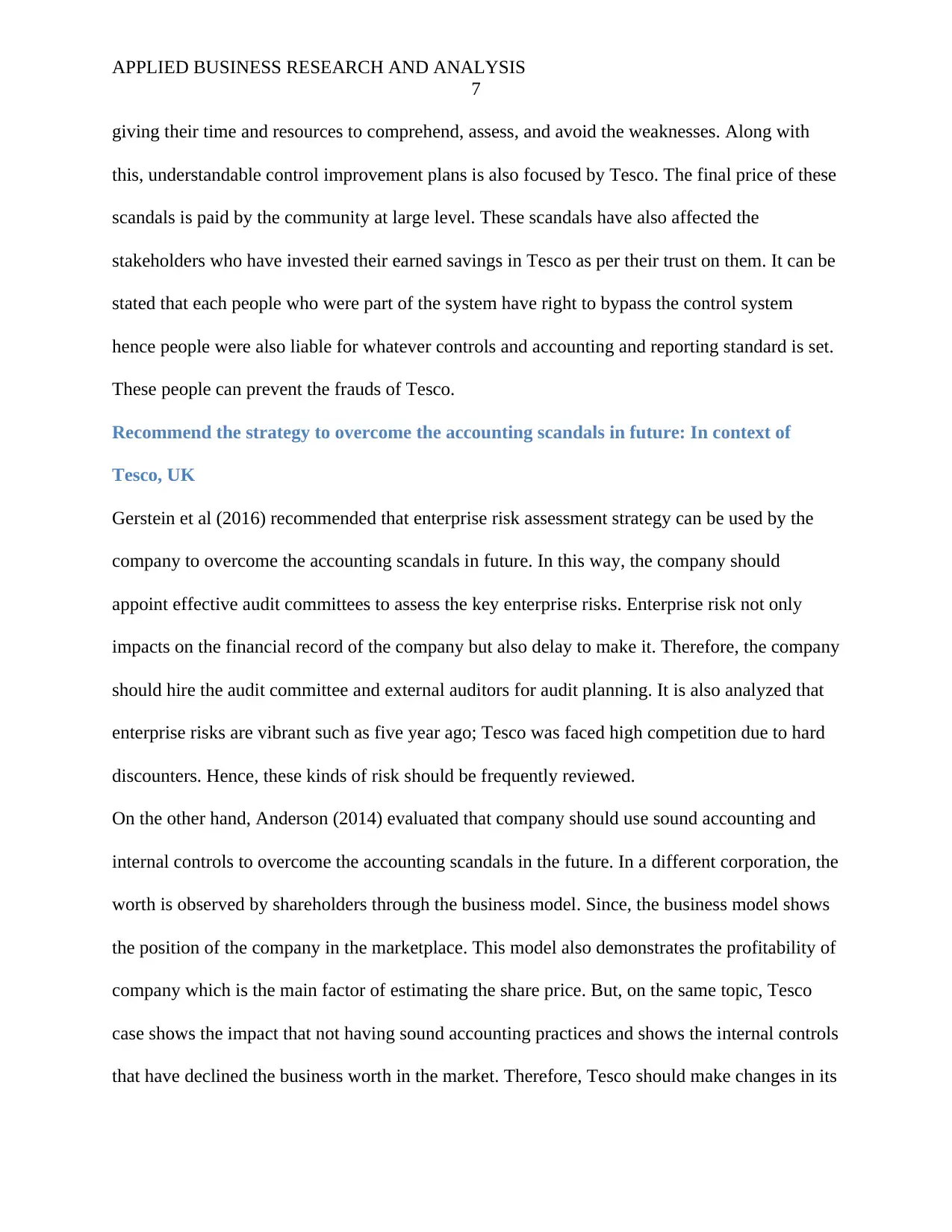
APPLIED BUSINESS RESEARCH AND ANALYSIS
7
giving their time and resources to comprehend, assess, and avoid the weaknesses. Along with
this, understandable control improvement plans is also focused by Tesco. The final price of these
scandals is paid by the community at large level. These scandals have also affected the
stakeholders who have invested their earned savings in Tesco as per their trust on them. It can be
stated that each people who were part of the system have right to bypass the control system
hence people were also liable for whatever controls and accounting and reporting standard is set.
These people can prevent the frauds of Tesco.
Recommend the strategy to overcome the accounting scandals in future: In context of
Tesco, UK
Gerstein et al (2016) recommended that enterprise risk assessment strategy can be used by the
company to overcome the accounting scandals in future. In this way, the company should
appoint effective audit committees to assess the key enterprise risks. Enterprise risk not only
impacts on the financial record of the company but also delay to make it. Therefore, the company
should hire the audit committee and external auditors for audit planning. It is also analyzed that
enterprise risks are vibrant such as five year ago; Tesco was faced high competition due to hard
discounters. Hence, these kinds of risk should be frequently reviewed.
On the other hand, Anderson (2014) evaluated that company should use sound accounting and
internal controls to overcome the accounting scandals in the future. In a different corporation, the
worth is observed by shareholders through the business model. Since, the business model shows
the position of the company in the marketplace. This model also demonstrates the profitability of
company which is the main factor of estimating the share price. But, on the same topic, Tesco
case shows the impact that not having sound accounting practices and shows the internal controls
that have declined the business worth in the market. Therefore, Tesco should make changes in its
7
giving their time and resources to comprehend, assess, and avoid the weaknesses. Along with
this, understandable control improvement plans is also focused by Tesco. The final price of these
scandals is paid by the community at large level. These scandals have also affected the
stakeholders who have invested their earned savings in Tesco as per their trust on them. It can be
stated that each people who were part of the system have right to bypass the control system
hence people were also liable for whatever controls and accounting and reporting standard is set.
These people can prevent the frauds of Tesco.
Recommend the strategy to overcome the accounting scandals in future: In context of
Tesco, UK
Gerstein et al (2016) recommended that enterprise risk assessment strategy can be used by the
company to overcome the accounting scandals in future. In this way, the company should
appoint effective audit committees to assess the key enterprise risks. Enterprise risk not only
impacts on the financial record of the company but also delay to make it. Therefore, the company
should hire the audit committee and external auditors for audit planning. It is also analyzed that
enterprise risks are vibrant such as five year ago; Tesco was faced high competition due to hard
discounters. Hence, these kinds of risk should be frequently reviewed.
On the other hand, Anderson (2014) evaluated that company should use sound accounting and
internal controls to overcome the accounting scandals in the future. In a different corporation, the
worth is observed by shareholders through the business model. Since, the business model shows
the position of the company in the marketplace. This model also demonstrates the profitability of
company which is the main factor of estimating the share price. But, on the same topic, Tesco
case shows the impact that not having sound accounting practices and shows the internal controls
that have declined the business worth in the market. Therefore, Tesco should make changes in its
Paraphrase This Document
Need a fresh take? Get an instant paraphrase of this document with our AI Paraphraser
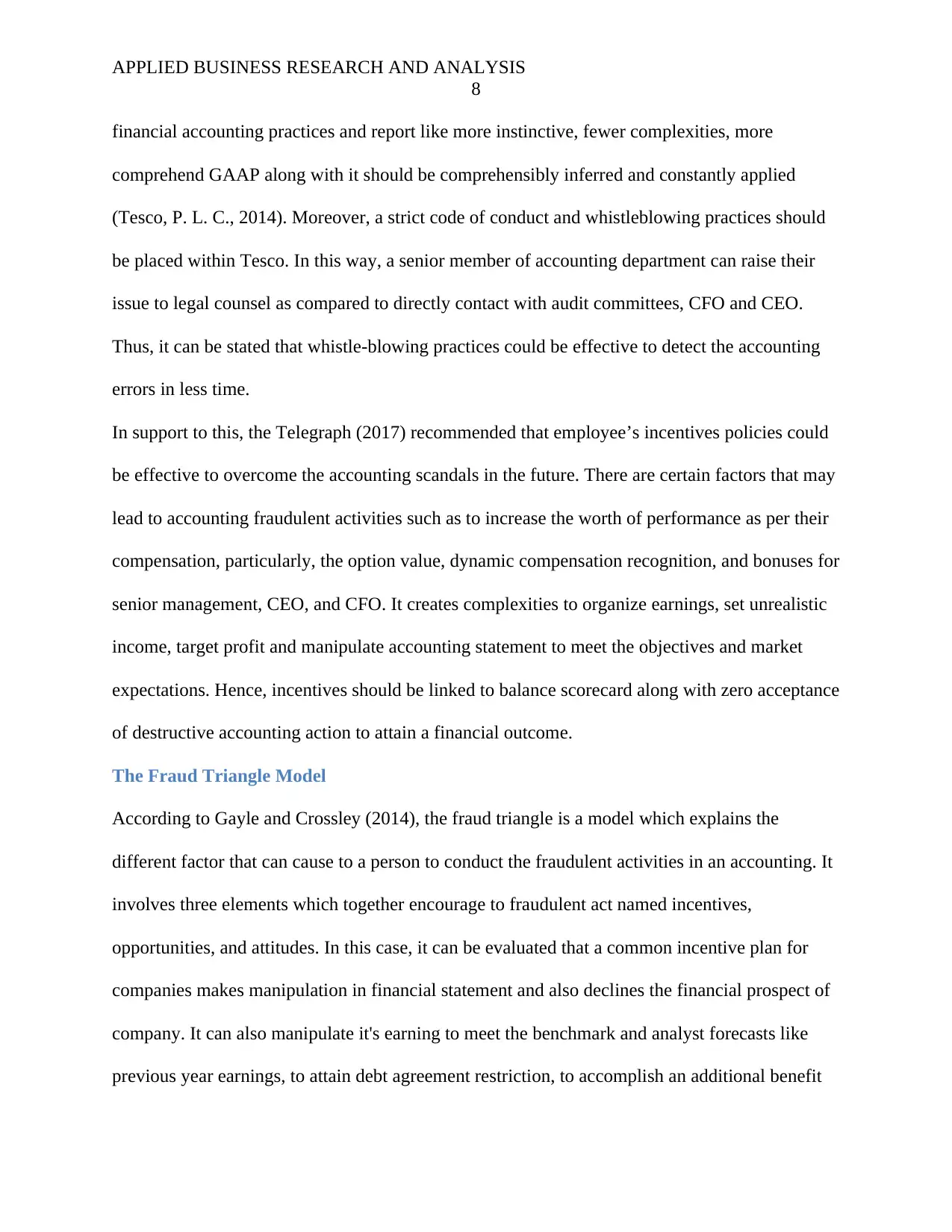
APPLIED BUSINESS RESEARCH AND ANALYSIS
8
financial accounting practices and report like more instinctive, fewer complexities, more
comprehend GAAP along with it should be comprehensibly inferred and constantly applied
(Tesco, P. L. C., 2014). Moreover, a strict code of conduct and whistleblowing practices should
be placed within Tesco. In this way, a senior member of accounting department can raise their
issue to legal counsel as compared to directly contact with audit committees, CFO and CEO.
Thus, it can be stated that whistle-blowing practices could be effective to detect the accounting
errors in less time.
In support to this, the Telegraph (2017) recommended that employee’s incentives policies could
be effective to overcome the accounting scandals in the future. There are certain factors that may
lead to accounting fraudulent activities such as to increase the worth of performance as per their
compensation, particularly, the option value, dynamic compensation recognition, and bonuses for
senior management, CEO, and CFO. It creates complexities to organize earnings, set unrealistic
income, target profit and manipulate accounting statement to meet the objectives and market
expectations. Hence, incentives should be linked to balance scorecard along with zero acceptance
of destructive accounting action to attain a financial outcome.
The Fraud Triangle Model
According to Gayle and Crossley (2014), the fraud triangle is a model which explains the
different factor that can cause to a person to conduct the fraudulent activities in an accounting. It
involves three elements which together encourage to fraudulent act named incentives,
opportunities, and attitudes. In this case, it can be evaluated that a common incentive plan for
companies makes manipulation in financial statement and also declines the financial prospect of
company. It can also manipulate it's earning to meet the benchmark and analyst forecasts like
previous year earnings, to attain debt agreement restriction, to accomplish an additional benefit
8
financial accounting practices and report like more instinctive, fewer complexities, more
comprehend GAAP along with it should be comprehensibly inferred and constantly applied
(Tesco, P. L. C., 2014). Moreover, a strict code of conduct and whistleblowing practices should
be placed within Tesco. In this way, a senior member of accounting department can raise their
issue to legal counsel as compared to directly contact with audit committees, CFO and CEO.
Thus, it can be stated that whistle-blowing practices could be effective to detect the accounting
errors in less time.
In support to this, the Telegraph (2017) recommended that employee’s incentives policies could
be effective to overcome the accounting scandals in the future. There are certain factors that may
lead to accounting fraudulent activities such as to increase the worth of performance as per their
compensation, particularly, the option value, dynamic compensation recognition, and bonuses for
senior management, CEO, and CFO. It creates complexities to organize earnings, set unrealistic
income, target profit and manipulate accounting statement to meet the objectives and market
expectations. Hence, incentives should be linked to balance scorecard along with zero acceptance
of destructive accounting action to attain a financial outcome.
The Fraud Triangle Model
According to Gayle and Crossley (2014), the fraud triangle is a model which explains the
different factor that can cause to a person to conduct the fraudulent activities in an accounting. It
involves three elements which together encourage to fraudulent act named incentives,
opportunities, and attitudes. In this case, it can be evaluated that a common incentive plan for
companies makes manipulation in financial statement and also declines the financial prospect of
company. It can also manipulate it's earning to meet the benchmark and analyst forecasts like
previous year earnings, to attain debt agreement restriction, to accomplish an additional benefit
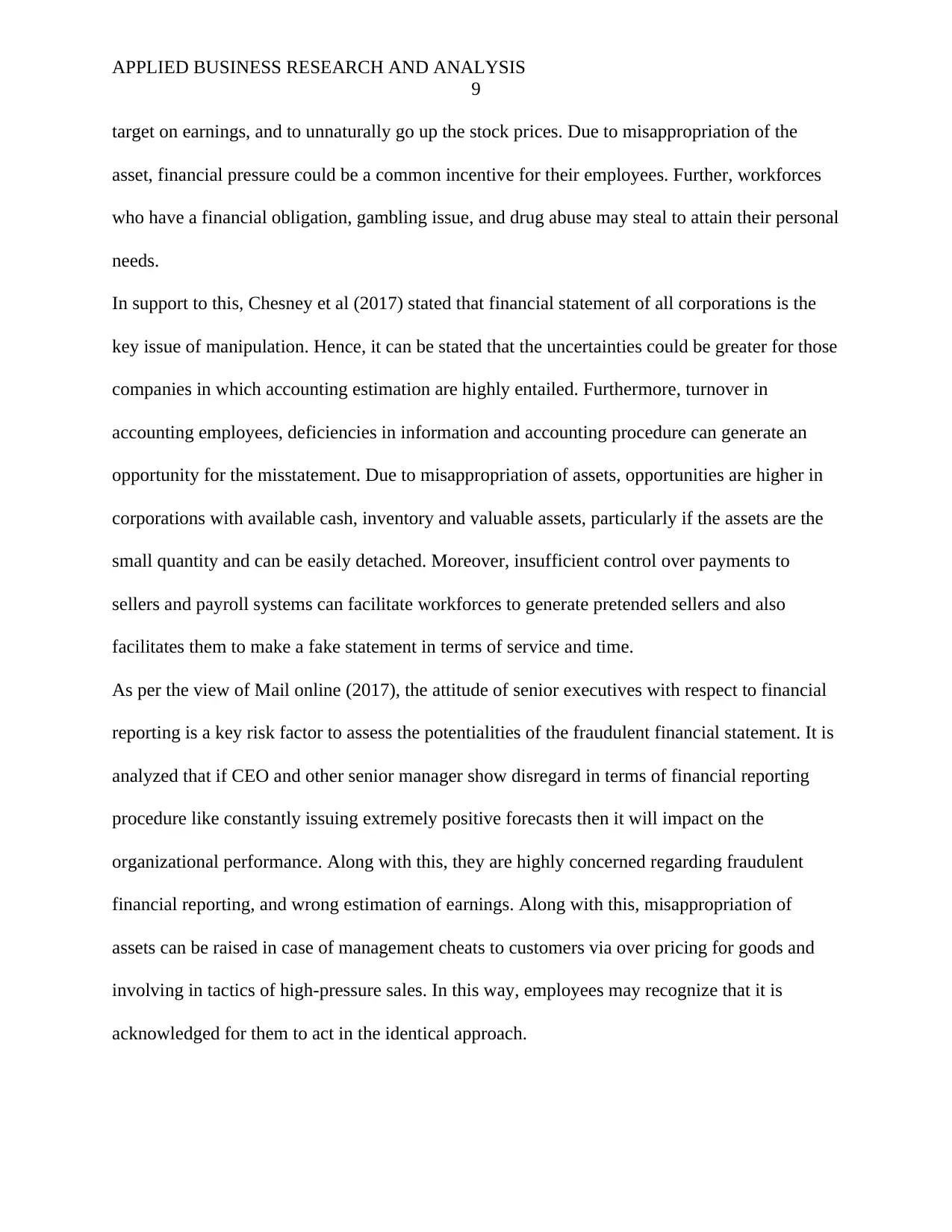
APPLIED BUSINESS RESEARCH AND ANALYSIS
9
target on earnings, and to unnaturally go up the stock prices. Due to misappropriation of the
asset, financial pressure could be a common incentive for their employees. Further, workforces
who have a financial obligation, gambling issue, and drug abuse may steal to attain their personal
needs.
In support to this, Chesney et al (2017) stated that financial statement of all corporations is the
key issue of manipulation. Hence, it can be stated that the uncertainties could be greater for those
companies in which accounting estimation are highly entailed. Furthermore, turnover in
accounting employees, deficiencies in information and accounting procedure can generate an
opportunity for the misstatement. Due to misappropriation of assets, opportunities are higher in
corporations with available cash, inventory and valuable assets, particularly if the assets are the
small quantity and can be easily detached. Moreover, insufficient control over payments to
sellers and payroll systems can facilitate workforces to generate pretended sellers and also
facilitates them to make a fake statement in terms of service and time.
As per the view of Mail online (2017), the attitude of senior executives with respect to financial
reporting is a key risk factor to assess the potentialities of the fraudulent financial statement. It is
analyzed that if CEO and other senior manager show disregard in terms of financial reporting
procedure like constantly issuing extremely positive forecasts then it will impact on the
organizational performance. Along with this, they are highly concerned regarding fraudulent
financial reporting, and wrong estimation of earnings. Along with this, misappropriation of
assets can be raised in case of management cheats to customers via over pricing for goods and
involving in tactics of high-pressure sales. In this way, employees may recognize that it is
acknowledged for them to act in the identical approach.
9
target on earnings, and to unnaturally go up the stock prices. Due to misappropriation of the
asset, financial pressure could be a common incentive for their employees. Further, workforces
who have a financial obligation, gambling issue, and drug abuse may steal to attain their personal
needs.
In support to this, Chesney et al (2017) stated that financial statement of all corporations is the
key issue of manipulation. Hence, it can be stated that the uncertainties could be greater for those
companies in which accounting estimation are highly entailed. Furthermore, turnover in
accounting employees, deficiencies in information and accounting procedure can generate an
opportunity for the misstatement. Due to misappropriation of assets, opportunities are higher in
corporations with available cash, inventory and valuable assets, particularly if the assets are the
small quantity and can be easily detached. Moreover, insufficient control over payments to
sellers and payroll systems can facilitate workforces to generate pretended sellers and also
facilitates them to make a fake statement in terms of service and time.
As per the view of Mail online (2017), the attitude of senior executives with respect to financial
reporting is a key risk factor to assess the potentialities of the fraudulent financial statement. It is
analyzed that if CEO and other senior manager show disregard in terms of financial reporting
procedure like constantly issuing extremely positive forecasts then it will impact on the
organizational performance. Along with this, they are highly concerned regarding fraudulent
financial reporting, and wrong estimation of earnings. Along with this, misappropriation of
assets can be raised in case of management cheats to customers via over pricing for goods and
involving in tactics of high-pressure sales. In this way, employees may recognize that it is
acknowledged for them to act in the identical approach.
⊘ This is a preview!⊘
Do you want full access?
Subscribe today to unlock all pages.

Trusted by 1+ million students worldwide
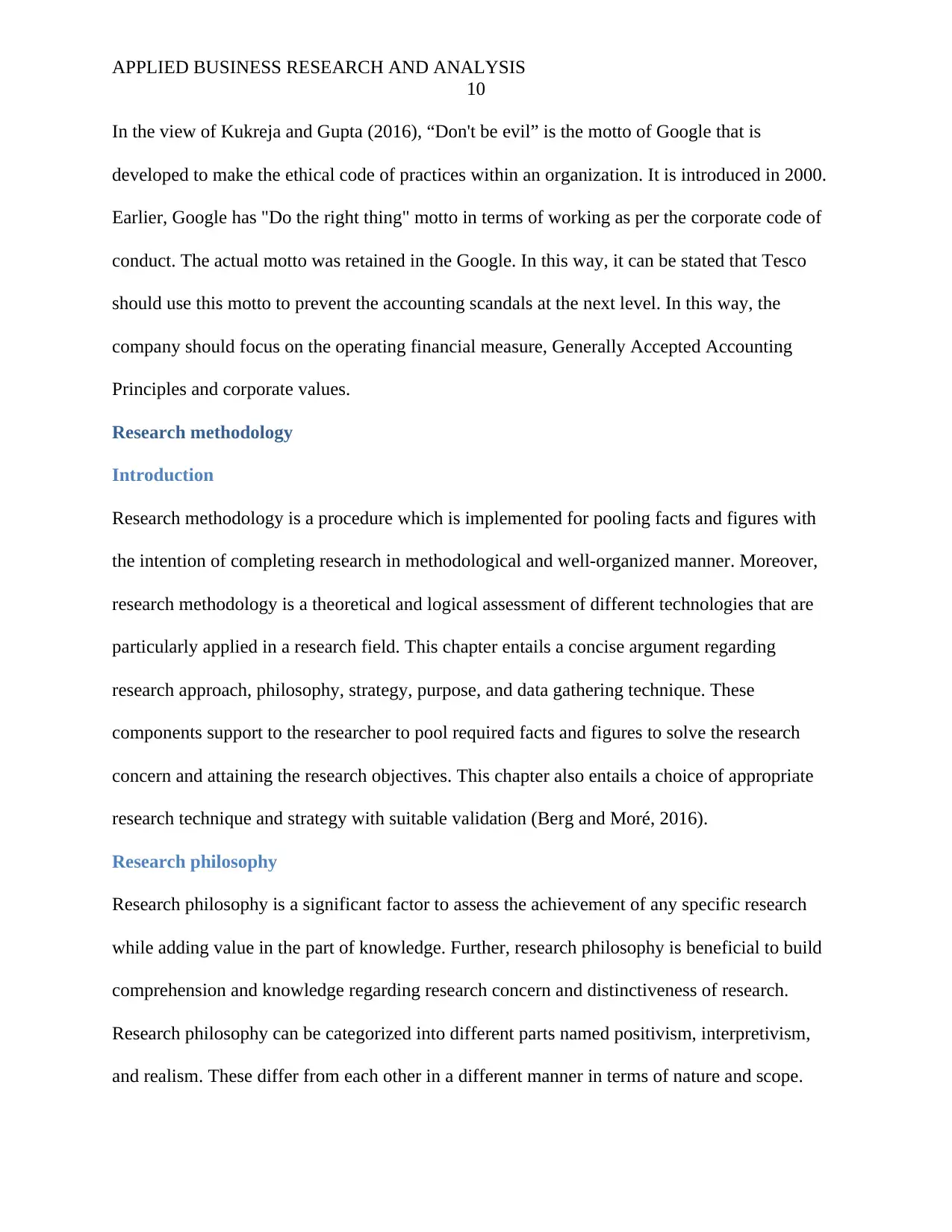
APPLIED BUSINESS RESEARCH AND ANALYSIS
10
In the view of Kukreja and Gupta (2016), “Don't be evil” is the motto of Google that is
developed to make the ethical code of practices within an organization. It is introduced in 2000.
Earlier, Google has "Do the right thing" motto in terms of working as per the corporate code of
conduct. The actual motto was retained in the Google. In this way, it can be stated that Tesco
should use this motto to prevent the accounting scandals at the next level. In this way, the
company should focus on the operating financial measure, Generally Accepted Accounting
Principles and corporate values.
Research methodology
Introduction
Research methodology is a procedure which is implemented for pooling facts and figures with
the intention of completing research in methodological and well-organized manner. Moreover,
research methodology is a theoretical and logical assessment of different technologies that are
particularly applied in a research field. This chapter entails a concise argument regarding
research approach, philosophy, strategy, purpose, and data gathering technique. These
components support to the researcher to pool required facts and figures to solve the research
concern and attaining the research objectives. This chapter also entails a choice of appropriate
research technique and strategy with suitable validation (Berg and Moré, 2016).
Research philosophy
Research philosophy is a significant factor to assess the achievement of any specific research
while adding value in the part of knowledge. Further, research philosophy is beneficial to build
comprehension and knowledge regarding research concern and distinctiveness of research.
Research philosophy can be categorized into different parts named positivism, interpretivism,
and realism. These differ from each other in a different manner in terms of nature and scope.
10
In the view of Kukreja and Gupta (2016), “Don't be evil” is the motto of Google that is
developed to make the ethical code of practices within an organization. It is introduced in 2000.
Earlier, Google has "Do the right thing" motto in terms of working as per the corporate code of
conduct. The actual motto was retained in the Google. In this way, it can be stated that Tesco
should use this motto to prevent the accounting scandals at the next level. In this way, the
company should focus on the operating financial measure, Generally Accepted Accounting
Principles and corporate values.
Research methodology
Introduction
Research methodology is a procedure which is implemented for pooling facts and figures with
the intention of completing research in methodological and well-organized manner. Moreover,
research methodology is a theoretical and logical assessment of different technologies that are
particularly applied in a research field. This chapter entails a concise argument regarding
research approach, philosophy, strategy, purpose, and data gathering technique. These
components support to the researcher to pool required facts and figures to solve the research
concern and attaining the research objectives. This chapter also entails a choice of appropriate
research technique and strategy with suitable validation (Berg and Moré, 2016).
Research philosophy
Research philosophy is a significant factor to assess the achievement of any specific research
while adding value in the part of knowledge. Further, research philosophy is beneficial to build
comprehension and knowledge regarding research concern and distinctiveness of research.
Research philosophy can be categorized into different parts named positivism, interpretivism,
and realism. These differ from each other in a different manner in terms of nature and scope.
Paraphrase This Document
Need a fresh take? Get an instant paraphrase of this document with our AI Paraphraser
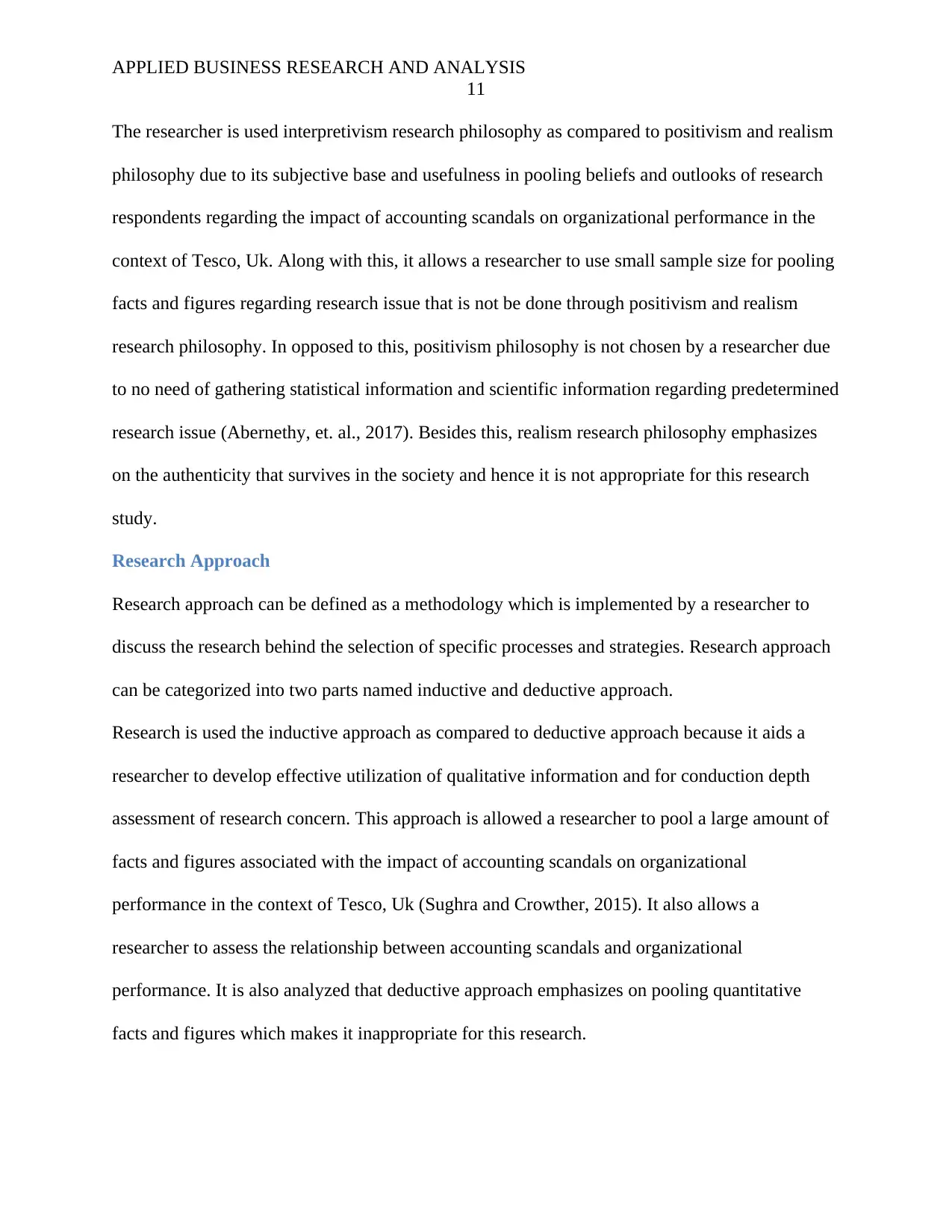
APPLIED BUSINESS RESEARCH AND ANALYSIS
11
The researcher is used interpretivism research philosophy as compared to positivism and realism
philosophy due to its subjective base and usefulness in pooling beliefs and outlooks of research
respondents regarding the impact of accounting scandals on organizational performance in the
context of Tesco, Uk. Along with this, it allows a researcher to use small sample size for pooling
facts and figures regarding research issue that is not be done through positivism and realism
research philosophy. In opposed to this, positivism philosophy is not chosen by a researcher due
to no need of gathering statistical information and scientific information regarding predetermined
research issue (Abernethy, et. al., 2017). Besides this, realism research philosophy emphasizes
on the authenticity that survives in the society and hence it is not appropriate for this research
study.
Research Approach
Research approach can be defined as a methodology which is implemented by a researcher to
discuss the research behind the selection of specific processes and strategies. Research approach
can be categorized into two parts named inductive and deductive approach.
Research is used the inductive approach as compared to deductive approach because it aids a
researcher to develop effective utilization of qualitative information and for conduction depth
assessment of research concern. This approach is allowed a researcher to pool a large amount of
facts and figures associated with the impact of accounting scandals on organizational
performance in the context of Tesco, Uk (Sughra and Crowther, 2015). It also allows a
researcher to assess the relationship between accounting scandals and organizational
performance. It is also analyzed that deductive approach emphasizes on pooling quantitative
facts and figures which makes it inappropriate for this research.
11
The researcher is used interpretivism research philosophy as compared to positivism and realism
philosophy due to its subjective base and usefulness in pooling beliefs and outlooks of research
respondents regarding the impact of accounting scandals on organizational performance in the
context of Tesco, Uk. Along with this, it allows a researcher to use small sample size for pooling
facts and figures regarding research issue that is not be done through positivism and realism
research philosophy. In opposed to this, positivism philosophy is not chosen by a researcher due
to no need of gathering statistical information and scientific information regarding predetermined
research issue (Abernethy, et. al., 2017). Besides this, realism research philosophy emphasizes
on the authenticity that survives in the society and hence it is not appropriate for this research
study.
Research Approach
Research approach can be defined as a methodology which is implemented by a researcher to
discuss the research behind the selection of specific processes and strategies. Research approach
can be categorized into two parts named inductive and deductive approach.
Research is used the inductive approach as compared to deductive approach because it aids a
researcher to develop effective utilization of qualitative information and for conduction depth
assessment of research concern. This approach is allowed a researcher to pool a large amount of
facts and figures associated with the impact of accounting scandals on organizational
performance in the context of Tesco, Uk (Sughra and Crowther, 2015). It also allows a
researcher to assess the relationship between accounting scandals and organizational
performance. It is also analyzed that deductive approach emphasizes on pooling quantitative
facts and figures which makes it inappropriate for this research.
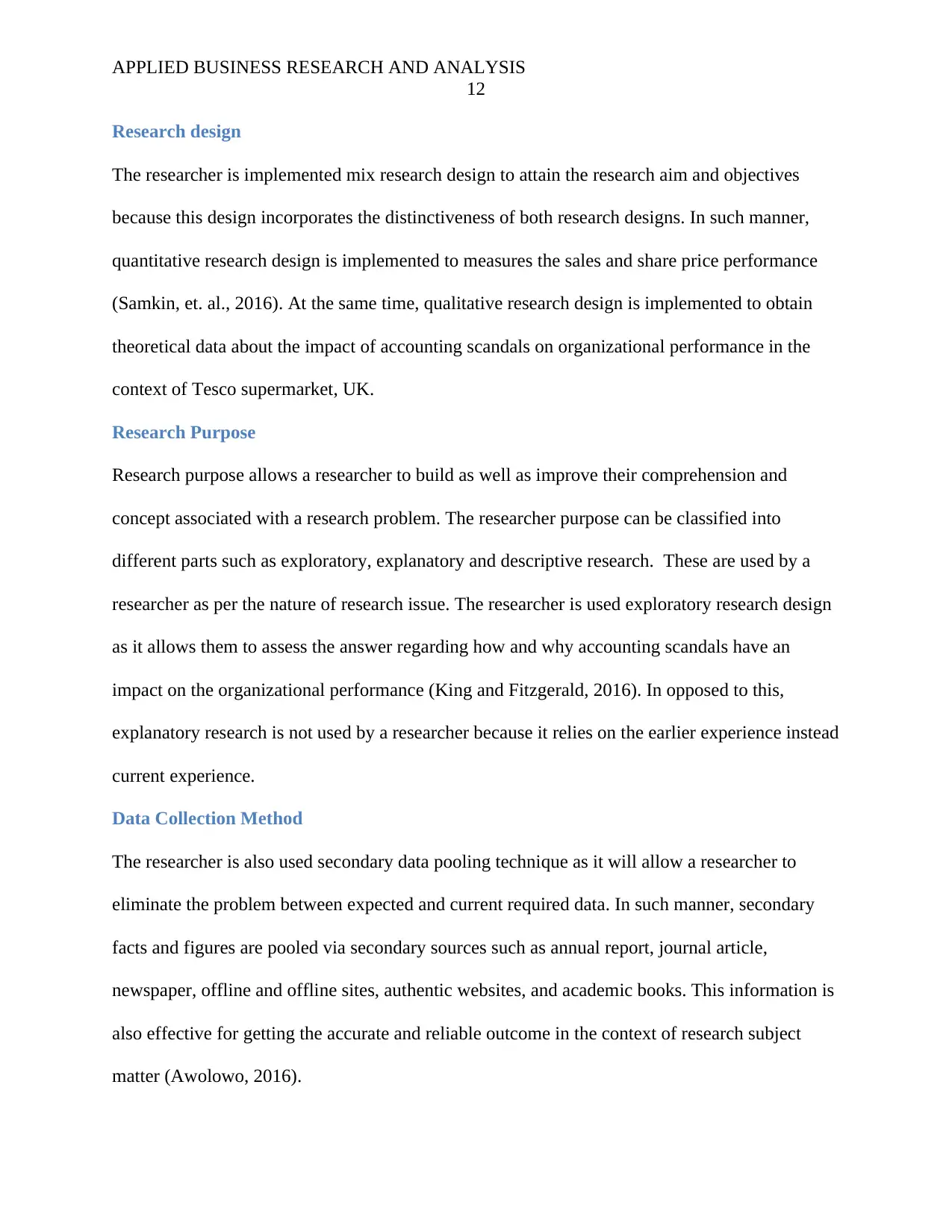
APPLIED BUSINESS RESEARCH AND ANALYSIS
12
Research design
The researcher is implemented mix research design to attain the research aim and objectives
because this design incorporates the distinctiveness of both research designs. In such manner,
quantitative research design is implemented to measures the sales and share price performance
(Samkin, et. al., 2016). At the same time, qualitative research design is implemented to obtain
theoretical data about the impact of accounting scandals on organizational performance in the
context of Tesco supermarket, UK.
Research Purpose
Research purpose allows a researcher to build as well as improve their comprehension and
concept associated with a research problem. The researcher purpose can be classified into
different parts such as exploratory, explanatory and descriptive research. These are used by a
researcher as per the nature of research issue. The researcher is used exploratory research design
as it allows them to assess the answer regarding how and why accounting scandals have an
impact on the organizational performance (King and Fitzgerald, 2016). In opposed to this,
explanatory research is not used by a researcher because it relies on the earlier experience instead
current experience.
Data Collection Method
The researcher is also used secondary data pooling technique as it will allow a researcher to
eliminate the problem between expected and current required data. In such manner, secondary
facts and figures are pooled via secondary sources such as annual report, journal article,
newspaper, offline and offline sites, authentic websites, and academic books. This information is
also effective for getting the accurate and reliable outcome in the context of research subject
matter (Awolowo, 2016).
12
Research design
The researcher is implemented mix research design to attain the research aim and objectives
because this design incorporates the distinctiveness of both research designs. In such manner,
quantitative research design is implemented to measures the sales and share price performance
(Samkin, et. al., 2016). At the same time, qualitative research design is implemented to obtain
theoretical data about the impact of accounting scandals on organizational performance in the
context of Tesco supermarket, UK.
Research Purpose
Research purpose allows a researcher to build as well as improve their comprehension and
concept associated with a research problem. The researcher purpose can be classified into
different parts such as exploratory, explanatory and descriptive research. These are used by a
researcher as per the nature of research issue. The researcher is used exploratory research design
as it allows them to assess the answer regarding how and why accounting scandals have an
impact on the organizational performance (King and Fitzgerald, 2016). In opposed to this,
explanatory research is not used by a researcher because it relies on the earlier experience instead
current experience.
Data Collection Method
The researcher is also used secondary data pooling technique as it will allow a researcher to
eliminate the problem between expected and current required data. In such manner, secondary
facts and figures are pooled via secondary sources such as annual report, journal article,
newspaper, offline and offline sites, authentic websites, and academic books. This information is
also effective for getting the accurate and reliable outcome in the context of research subject
matter (Awolowo, 2016).
⊘ This is a preview!⊘
Do you want full access?
Subscribe today to unlock all pages.

Trusted by 1+ million students worldwide
1 out of 24
Related Documents
Your All-in-One AI-Powered Toolkit for Academic Success.
+13062052269
info@desklib.com
Available 24*7 on WhatsApp / Email
![[object Object]](/_next/static/media/star-bottom.7253800d.svg)
Unlock your academic potential
Copyright © 2020–2025 A2Z Services. All Rights Reserved. Developed and managed by ZUCOL.





